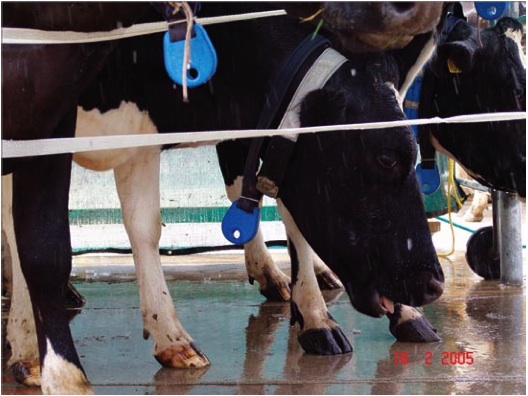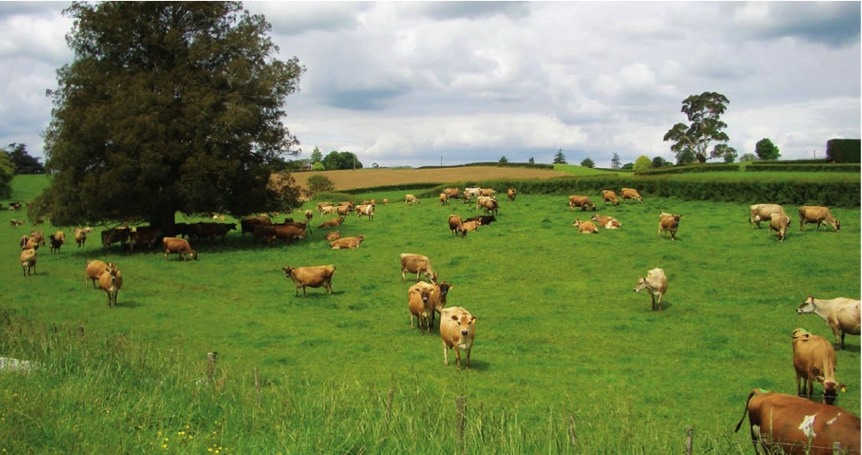In summer, shade rules: The science behind why trees help maintain dairy productivity
Gwyneth Verkerk, New Zealand Tree Grower February 2009.
Cows feel the heat of summer more than many farmers realise. However they do need to use the energy normally required for physiological processes to cool down, so if they can be protected from the effects of hot weather, their appetite and intake will be maintained and productivity conserved.
Effective heat management for dairy farms requires an integrated approach. This needs to assesses farm risk, explore ways to reduce heat loading and employ short term management changes during high risk hot weather. On farms with moderate to high risk of heat exposure, the best way to reduce overall heat loading is to provide shade, and natural shade from trees can be very effective.
What is heat load?
Cows need to maintain their core body temperature at around 39°C with a normal fluctuation of about 0.7°C every 24 hours. This is the cow’s thermo-neutral or thermal comfort zone. Core temperature is the result of balancing heat loading and heat dissipation, a continuous process.
Dairy cows generate heat as their food is digested and as they make milk. This makes them quite resistant to cold, but during hot conditions it can overload their system. Large food intakes and high production rates also mean more heat is generated.
Walking to and from the dairy, to the water trough and grazing all increase heat generation by muscular activity. Radiant heat from the sun contributes to heat load and when the summer sun is intense this contribution can be large. Cows with dark coloured coats absorb more radiant heat than cows with light coloured coats.
Looking for shade
Cows unload heat in several ways. There is convective heat loss to the air around them which is increased by air movement and wind. Mature and heavy cows have a lower surface area to volume ratio so their convective heat loss is less effective than younger lighter cows. Cows can also sweat a little, especially the more heat tolerant breeds, such as Jerseys, and will drink more water when hot to help unload the heat.
Once core temperature gets above the thermal comfort zone, the cow will use the evaporative cooling system of her lungs and air passages and will increase her rate of breathing. Unfortunately high air temperatures and humidity reduce the efficiency of this cooling system. Under such conditions a cow may not unload effectively and can have prolonged periods when core temperature is outside her thermal comfort zone.
Cows also display a number of behavioural strategies that assist heat unloading. They actively seek shade, and may gather in groups to get shade from herd mates if other shade is not available. They also look for places where air movement is high, such as rises and hilltops. When hot they stand to maximise the body surface area that is exposed to the air. A hot cow will stop eating, will hang around the water trough and may splash or stand in the water.

An increased respiration rate above 60 breaths a minute is amongst the first behavioural evidence that cows are developing heat stress. If behavioural tactics do not allow her to manage heat load, she will start to pant, breathe through an open mouth, drool and hang out her tongue.
Heat load and production loss
Temperature and humidity influence the cow’s ability to deal with her heat load. They can be combined in a temperature-humidity index (THI) which is a good predictor of whether cows will develop signs of heat stress. Signs of mild heat stress, such as increased breathing rate and shade seeking behaviour, appear when the THI is in the range of 68 to 75 – lower for high producing Holstein-Friesians and higher for Jerseys. A THI of 72 is generated when air temperature is 26°C and relative humidity is 40 per cent, but when relative humidity is 80 per cent it is generated with an air temperature of only 23°C.
Even mild heat stress can cause production loss. Using data from across New Zealand, Jeremy Bryant showed that production is reduced by 10 grams of milk solids per cow for each unit increase in THI above 68.
The value of providing shade to reduce summer production loss in pasture-fed cows in Waikato was demonstrated in work published in 2006. The weather conditions were relatively moderate with a THI greater than 72 during only 2.4 per cent of the observation period and a mean THI of 63. However, cows provided with artificial shade structures in their pasture area produced 1.7 per cent more milk solids a day than cows without shade. Shaded cows had lower core temperatures between midday and afternoon milking and spent more time grazing at night.
The DairyNZ website has a simple THI calculator which you can use to assess your risk of production loss from unfavourable thermal comfort conditions for your cows.
Shade helping cows manage heat load
Shade protects cows from the additional heat load of solar radiation. Good shade can reduce radiant heat load in half. Behavioural studies show that cows place a high value on shade. In a recent study cows were prevented from lying down and then observed for an hour after they were offered the choice of lying in the open or standing under shade.
Cows that had not lain down for 12 hours spent 25 per cent of the observation period lying in the open when conditions were less than 25°C. However when air temperature was above 30° they were more restless and did not lie down in the open area at all, preferring to stand in the shade. In another study, cows spent more time in the shade on days with higher solar radiation and ambient temperature, and preferred shade that offered more than 50 per cent reduction in solar radiation. Mean core temperature was lowest in cows that used shade providing the greatest reduction.
What can I do when my cows get hot?
There are a number of short-term management options available when signs of heat stress occur. These include –
- Putting cows into paddocks that are closer to the dairy or that have more natural shade
- Changing milking times away from the heat of the day
- Moving cows at their own pace
- Providing drinking water at the dairy
- Providing shade in yards
- Sprinkling cows so their coat is wet to the skin
- Making dietary adjustments to provide feeds that are more slowly fermented.
Managing heat load is an energy cost for the cow, so prevention is more productive than trying to manage the consequences once cows are heat stressed. Proactive reduction of heat load by protecting cows from solar radiation will result in production gains. Providing good access to shade is the simplest means of proactive management to reduce heat load. Providing natural shade with trees is a relatively cheap option that also benefits your farm’s landscape and supports biodiversity.
If you farm in an area where THI regularly exceeds 70 during summer months, or your herd is more susceptible to heat stress, then you should consider ways to reduce overall heat load on your cows. Such plans will inevitably include increasing the amount of shade provided.
The case for trees
Trees are a good low cost option to increase available shade on the farm, even though they do take time to establish and grow if they are to cater for herds of cows. Cattle will generally choose trees over artificial shade if both are available. It is thought that evaporative heat loss from leaves also cools the air around trees. Trees are more effective at blocking radiant heat than most artificial shade structures which may even increase ambient temperatures.
Wide crowned trees that produce dense shade but are open around the trunk are preferable to minimise wind speed reductions. Tree lines should be established on the northern and western edges of pasture so that shade is accessible during the hotter afternoon hours. A shade area allowance of around four square metres per cow will ensure ready access for all.
Deciduous is better
Deciduous trees are most useful as they reduce the effect of pasture shading and root competition on pasture production. Planting along laneways provides protection as cows walk to and from the dairy, and deciduous trees are preferred to reduce mud on lanes during winter. Planting native species and flowering trees within tree lines encourages birdlife. Trees such as poplars and willows grow quickly and can be coppiced to provide feed during drought and woodchips for bedding on stand-off areas.
Trees should be fenced off and protected from damage. Where they will provide shade for large groups of cows, fences should be at the root margin to prevent damage to the root system from treading and soil compaction.
Cows may be exposed to more mud and dung under trees and this should be considered in mastitis management plans. Where air flow is diminished by trees, microclimates may be established that increase facial eczema risk, so these paddocks should be carefully managed with grazing restricted in these areas during conditions that favour high spore counts.

Gwyneth Verkerk is a scientist with DairyNZ

 Farm Forestry New Zealand
Farm Forestry New Zealand

